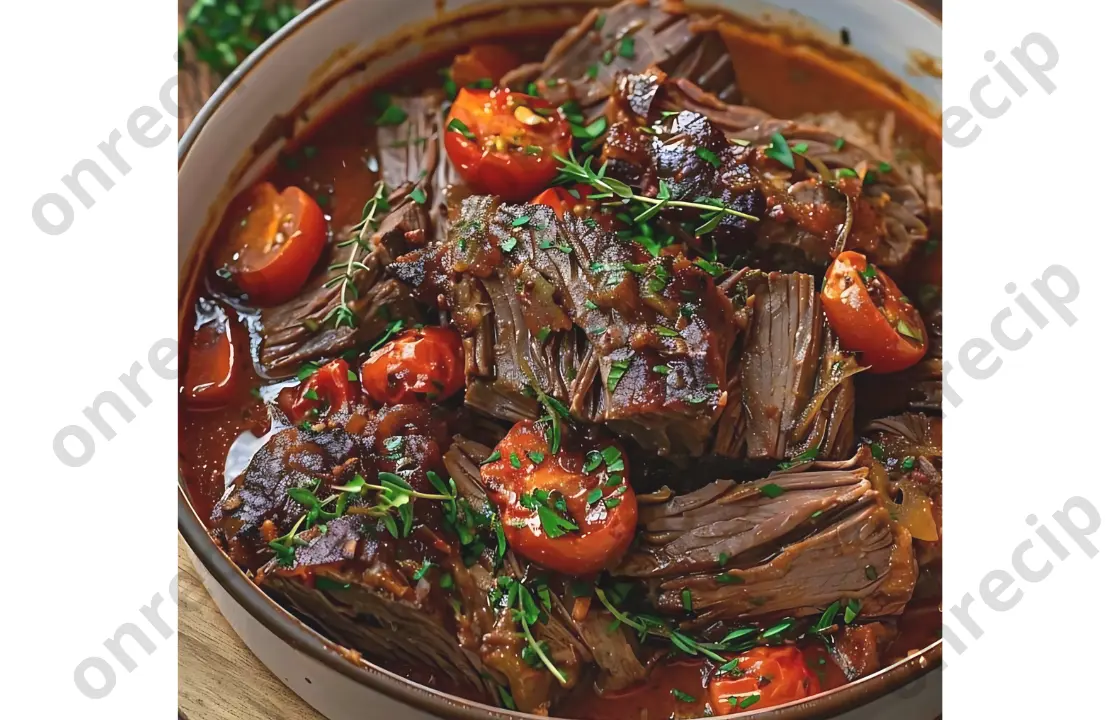Tuscan-Style Slow-Cooked Beef Roast: A Comforting Italian Classic
Indulge in the rustic charm of Tuscan-Style Slow-Cooked Beef Roast, a dish inspired by the traditional Italian Pot Roast, also known as “Straccato.” This hearty, flavorful meal combines tender beef with aromatic herbs and vegetables, slow-cooked to perfection. Ideal for a cozy family dinner, this recipe promises to fill your home with enticing aromas and deliver mouthwatering flavors in every bite.
Ingredients for Tuscan-Style Beef Roast
Essential Ingredients:
- 2 lbs beef chuck roast
- 1 tablespoon olive oil
- 1 onion, chopped
- 2 carrots, chopped
- 2 stalks celery, chopped
- 3 cloves garlic, minced
For the Sauce:
- 2 cups beef broth
- 1 (14-ounce) can crushed tomatoes
- 1 teaspoon dried rosemary
- 1 teaspoon dried thyme
- Salt and pepper to taste
Garnish:
- 2 tablespoons fresh parsley, chopped
Step-by-Step Instructions
Step 1: Prepare the Beef
- Heat olive oil in a large pot or Dutch oven over medium-high heat.
- Season the beef chuck roast generously with salt and pepper.
- Sear the beef in the hot oil, browning all sides for about 4–5 minutes per side. This step locks in the juices and adds a rich depth of flavor.
- Remove the beef from the pot and set it aside.
Step 2: Cook the Aromatic Vegetables
- In the same pot, add the chopped onion, carrots, celery, and minced garlic.
- Sauté for 5 minutes or until the vegetables are softened and fragrant.
Step 3: Combine and Simmer
- Return the seared beef to the pot, nestling it among the sautéed vegetables.
- Pour in the beef broth and crushed tomatoes, ensuring the beef is mostly submerged.
- Sprinkle the dried rosemary and thyme over the mixture. Stir gently to combine.
Step 4: Slow-Cook to Perfection
- Bring the pot to a gentle boil, then reduce the heat to low. Cover with a tight-fitting lid.
- Simmer for 3–4 hours, occasionally stirring to ensure even cooking. The beef should become tender and easy to shred with a fork.
Step 5: Shred and Serve
- Once the beef is tender, use two forks to shred it directly in the pot.
- Stir the shredded beef into the sauce, allowing it to soak up the rich flavors.
- Garnish with freshly chopped parsley before serving.
Serving Suggestions
- Classic Pairings: Serve this slow-cooked beef roast over creamy polenta, buttery mashed potatoes, or egg noodles for a comforting meal.
- Rustic Bread: Pair with crusty Tuscan bread to mop up every bit of the delicious sauce.
- Side Dishes: A fresh green salad or roasted vegetables make excellent accompaniments.
Tips for a Perfect Tuscan Beef Roast
- Choose the Right Cut: Beef chuck roast is ideal for slow-cooking due to its marbling, which breaks down beautifully, creating tender, juicy meat.
- Make It Ahead: This dish tastes even better the next day as the flavors meld. Prepare it a day in advance for maximum flavor.
- Herb Substitutes: Swap rosemary and thyme for fresh herbs if available, or try oregano for a slightly different flavor profile.
- Customize the Sauce: Add a splash of red wine or balsamic vinegar for added depth.
Why You’ll Love This Recipe
This Tuscan-Style Slow-Cooked Beef Roast is the ultimate comfort food. It’s easy to prepare, requires minimal effort, and delivers maximum flavor. Whether you’re hosting a dinner party or enjoying a quiet night with family, this dish is guaranteed to impress. The rich, savory sauce combined with tender, melt-in-your-mouth beef will have everyone asking for seconds.
Nutritional Information
- Calories: 430 kcal per serving
- Servings: 6
Final Thoughts
If you’re searching for a hearty and satisfying meal that’s simple yet packed with flavor, look no further than this Tuscan-Style Slow-Cooked Beef Roast. Its rich, comforting flavors and minimal hands-on preparation make it a go-to recipe for any occasion. Try it today and experience the warmth of Tuscany right at your dinner table.





